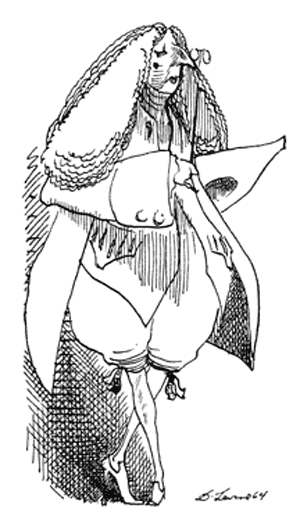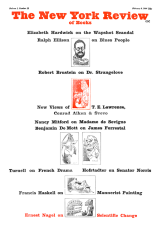“I recommend theatrical representations to you, which are excellent in Paris,” said Lord Chesterfield in a letter to his son. “The tragedies of Corneille and Racine, and the comedies of Molière, well attended to, are admirable lessons, both for the heart and the head. There is not, nor ever was, any theater comparable to the French.”
Lord Chesterfield was writing as a member of a small intellectual élite, but we must applaud the breadth and catholicity of the eighteenth-century aristocrat’s taste. We must also lament the slowness of his countrymen in following his enlightened lead. Molière has always been a favorite with Anglo-Saxon audiences, but the two great French tragic dramatists have long been a stumbling block. The day is happily past when a Lytton Strachey could declare that Englishmen had always “detested” Racine, or when visiting French theatrical companies felt that it was too much of a risk to mount any of his plays in London. He now has a small and devoted following in English-speaking countries. A few years ago Mme Edwige Feuillère altered her schedules and prolonged her stay in London so that she could play Phèdre at every performance for a week at a West End theatre, which she did to packed houses. More recently the Marie Bell company played three of the major tragedies for a week each in the proper style: straight through without an interval for rest and refreshment. Once again the house was packed.
Corneille, a more difficult writer because he is an exponent of an unfashionable heroism, has been less fortunate. I cannot remember a production of any of his plays in London since the Gaston Baty company did Le Cid in the early Thirties. He has been described in his own country as “our Shakespeare,” but not long ago an Oxford don remarked, a trifle patronizingly, that though Le Cid was “an excellent play,” it had never occurred to him to think any part of it “poetic.”
Lord Chesterfield was right in commending all three dramatists to his son and those critics have been wrong who praised Racine at the expense of Corneille, or Molière at the expense of both. They are masters in the sense that each gives consummate expression to a particular phase of human experience, that each represents one of the “constants” of the French genius. We shall really understand them only when we have come to feel that all three are necessary to us, and that the absence of one of them would have left a gap which neither of the others could have filled.
The difficulty lies in accustoming ourselves to a form of poetry which is very unlike the native product. It is largely a matter of language and versification. Sixteenth-century French possessed a good deal of the rude earthy vigor, the richness and concreteness of English. These qualities were swept away by a linguistic revolution that took place at the beginning of the seventeenth century and was designed to purge French of the “baroque” elements still apparent in Corneille’s early comedies. A famous nineteenth-century French critic could say of the “classical” language which emerged that “Racine described the extremes of passion in a style that was abstract, frigid and diplomatic.” It is this which has often given the impression that the work of the seventeenth-century masters was remote from the life of their own time and of ours.
The versification, which was used by Molière in some of his greatest comedies as well as by Corneille and Racine, sometimes looks as forbidding as the language. Yet in a curious way it brings out the connection between the three dramatists. The perfection of the alexandrine in the seventeenth century reflects the outer shape of society, but within the formal framework there was room for infinite subtleties and variations. Corneille’s alexandrine was a rougher instrument than Racine’s. He was the product of an age of violence and disorder. We are aware in his verse of a continual endeavor to impose order on the chaos of human feeling. The climax of his plays is the transcendent moment—the moment of vision—when the protagonist resolves the interior conflicts and sees himself as a fully integrated individual. Racine reverses the process. He shows the disruptive effects of passion, the explosive forces which are an imminent threat to a precarious order. This gives the plays their extraordinary tension. Molière’s approach is different again. He is a severe critic of human failings, but he sees them as flaws in a fundamentally stable order. The formal versification is an expression of this confidence: a confidence guaranteed, as it were, by the unique position of the monarch who at the close of Tartuffe intervenes to restore the threatened order.
Advertisement
The three books under review are all by academics. Although they contain between them much that is helpful, they are in no sense popular introductions. They are primarily studies written by teachers for pupils who are assumed to have a working knowledge of the subject. Dr. Yarrow’s book is the first full-length study of Corneille to appear in English for many years. He rightly insists that Corneille’s work is rooted in his age, but his account of the background is inclined to be slapdash and is overloaded by extracts from contemporary documents. The main weakness, however, is the absence of a sustained appreciation of a single one of the major plays. The author prefers the broad surveys and dwells on the different “periods” of Corneille’s output, on “aspects” of the tragedies and on the supposed “affinities” between the comedies and the tragedies. He thinks that too much has been made of the Cornelian “superman.” He tries to scale him down by producing, as a corrective, the magic word “realism”: realism in relation to character, to the age, to history and to political theory. This leads to some trite phrases about Corneille’s excellence in depicting “family life.” His most satisfying chapter is the sensitive appraisal of Corneille as a poet which is useful and long overdue.
Professor Weinberg makes no concessions to the common reader or to anybody else. He has written a specialized study of the structure of Racine’s tragedies. He is mainly concerned with technical problems such as the function of the protagonist in giving, or in failing to give, unity to the individual play. “This,” he remarks depressingly in his introduction, “will resolve itself, in each chapter, into a set of consecutive questions: What successful solutions has he already found, and how will he improve upon them? What failings are apparent, and how will he eliminate them?…What failings persist or reappear? In what areas is there constant improvement?”
It will be seen that the professor’s touch is not exactly a light one. Racine’s plays, we discover, are riddled with technical faults. Andromaque, usually regarded as the first of the masterpieces, scores a poorish mark. It has some good scenes and passages, but when we look at it as a whole we find that the dramatist “remained uncertain and groping.” Britannicus is another miss, but a “near miss” this time. Its “one flaw consists in…the division of interest between a tragic personage who is not a hero and a protagonist who is not tragic.” Phèdre alone appears to be a complete success because the “plot [is] firmly centred about his protagonist, involving clear movement from beginning to end.”
Mr. Gossman’s able study of Molière is the most attractive and stimulating of the three books. He devotes his first five chapters to detailed discussions of five of the principal comedies. He then goes on to consider “Molière in his Own Time” and the development of the drama “After Molière.” His concept of the “mask” is based on a study of seventeenth-century and contemporary philosophy. In brief, it is the distinction between être and paraître, between what a man is and what he wants to appear. The protagonists all suffer from a form of “inauthenticity” which they do their utmost, whether consciously or unconsciously, to conceal behind a “mask.” It is a failing which applies as much to Orgon as to Tartuffe, to Alceste as to Célimène. Mr. Gossman goes on to argue that in this world nothing has value in itself; its value—usually a spurious value—is conferred by the “opinion of other people.” The beloved is not desired for her intrinsic virtues; her value, in the eyes of her lover, lies in her refusal to be “possessed.” “The whole universe which revolves round Célimène…,” we are told, “is in fact held together and propelled by vanity.” He makes some interesting observations on the tendency to “idolatry”: the idolatry of Orgon for Tartuffe which at bottom springs from a desire of domination. Mr. Gossman implies that Molière’s criticism went deeper than he himself intended or realized. While there can be no direct comparison between Orgon’s attitude to Tartuffe and that of the courtier to the King, Tartuffe nevertheless “reveals a pattern of behavior that was to become characteristic of the society of the Court too, as the absolute monarchy gradually lost its grip on events and turned out itself unable to provide more than a formal solution to the real social and political conflicts within the state.”
The next chapter contains some provocative comparisons between Molière and the other two dramatists. Mr. Gossman casts doubts, for example, on the authenticity of the Cornelian hero and suggests that heroism is in fact another “mask” which conceals an “abyss.” There is an equally provocative comparison between the lovers in Le Misanthrope and those in Andromaque which he regards as verging on comedy. Just as Alceste would have had no use for a Célimène who could be “possessed,” so he thinks that Oreste would have ceased to love Hermione and Hermione have ceased to love Pyrrhus if their love had been returned. His verdict on the age is a somber one: “Violence that concealed weakness, willfulness that concealed despair and fear, order that concealed anarchy, these are the characteristic manifestations of the world of the early and mid-seventeenth century.”
Advertisement
This Issue
February 6, 1964




